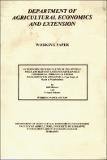| dc.contributor.author | Manase, Gift | |
| dc.contributor.author | Sukume, Crispen | |
| dc.coverage.spatial | Zimbabwe. | en |
| dc.date.accessioned | 2015-08-07T09:38:22Z | |
| dc.date.available | 2015-08-07T09:38:22Z | |
| dc.date.issued | 1999-02 | |
| dc.identifier.citation | Manase, G. & Sukume, C. (1999) An Economic Determination of the Optimal Price and Harvest Rates for Sustainable Commercial Indigenous Timber Management in Zimbabwe: A Case Study of Mzola in Matebeleland. AEE Working Paper no. 5/99. UZ, Mt. Pleasant, Harare: DAEE. | en |
| dc.identifier.uri | https://opendocs.ids.ac.uk/opendocs/handle/20.500.12413/6683 | |
| dc.description | An AEE Working Paper on rural development in Zimbabwe's Matebeleland Province. | en |
| dc.description.abstract | A number of reports (see Judge, 1975, World Bank, 1993, Forestry Commission, 1995, Mushove, 1994) show that Commercial Indigenous Timber (CIT) appears to be exploited at an unsustainable rate. Over-exploitation and wasteful utilization of the forest resource may be due to undervaluing of the resource and wrong pricing mechanisms. The main objective of this study was to determine the optimal price and the Maximum Sustainable Economic Yield (MSEY) which will maximize the Net Present Value of the forest resource. This study differs from previous studies because it does not just explain the problems and causes of over exploitation of the forest resource, but it goes beyond by determining the prices and the MSEY which will encourage sustainable CIT management.
To achieve the study objectives, we use the residual approach to determine the residual stumpage value (the value of a standing tree in the forest) of teak and mukwa. The results show that both teak and mukwa are undervalued by 76% and 77% respectively since the FC is charging Z$450/m3 for teak and Z$700/m^ for mukwa yet the results of this study show that the stumpage value of teak is Z$1900/m3 and that of mukwa is Z$3119/m^. This method was also used by Mushove, 1994 and he found that mukwa was undervalued by 63%. However, the residual approach has the major weakness of calculating a residual stumpage value which depends on the logging, transportation, and processing costs of the Finns. If the firms are inefficient the resulting residual value will be low thus rewarding inefficiency. The residual approach also determine a static value which does not reflect the scarcity value of the resource and does not help in achieving intertemporal allocative efficiency.
To overcome these weaknesses a model which incorporates biological and economic information (Bioeconomic Model) was developed to determine the MSEY and the Marginal User Cost (MUC) over time. The results show that in order to achieve intertemporal allocative efficiency of the resource, the exploitation rate should fall progressively until the harvest rate equals the growth rate of the resource and the price of the resource should increase as the resource become scarce. The results at 5% discount rate show that a maximum Net Present Value of Z$26 930 961 can be earned in 24 years. The price per cubic meter will increase from the current Z$700/m^ to Z$1500/m^ in real terms during the same period.
This study has not concentrated effort on the institutions and the political economics which underline the allocatory and pricing decisions of state owned and communal resources but it has established criteria which the Forestry Commission can use to reduce political manipulation of prices.
It is recommended that the Forestry Commission should charge per tree fees to encourage efficient utilization of the forest resource. It is also recommended that the price calculated using the Bioeconomic model should form the minimum prices below which timber may not be sold. | en |
| dc.language.iso | en | en |
| dc.publisher | Department Of Agricultural Economics and Extension (DAEE) (University of Zimbabwe) (UZ) | en |
| dc.relation.ispartofseries | Working Paper AEE;5/99 | |
| dc.rights.uri | http://creativecommons.org/licenses/by-nc-nd/3.0/ | en |
| dc.subject | Environment | en |
| dc.subject | Rural Development | en |
| dc.subject | Trade | en |
| dc.title | An Economic Determination of the Optimal Price and Harvest Rates for Sustainable Commercial Indigenous Timber Management in Zimbabwe: A Case Study of Mzola in Matebeleland | en |
| dc.type | Series paper (non-IDS) | en |
| dc.rights.holder | University of Zimbabwe (UZ) | en |


